Recently, the introduction of AI photo generation tools has sparked concerns among cybersecurity experts about the potential rise in fake Aadhaar cards, passports, and KYC documents. The development of features like ChatGPT’s photo generation capabilities has opened up a new avenue for cybercriminals to exploit and create highly realistic fake identification documents that are difficult to distinguish from genuine ones.
The inclusion of a photo generation feature in ChatGPT by OpenAI has raised red flags within the cybersecurity community. While this feature has innovative applications in terms of creativity and productivity, it also presents a significant security risk. Experts are worried that malicious actors could leverage this tool to produce counterfeit ID documents at scale, leading to widespread fraud and identity theft.
One of the major concerns surrounding AI-generated fake documents is the threat they pose to various sectors, particularly in terms of KYC fraud. Industries such as banking, insurance, telecom, logistics, education, and healthcare are at high risk of falling victim to fraudulent activities enabled by falsified identification documents. By utilizing AI tools, scammers can easily fabricate ID proofs and carry out illicit financial activities by assuming the identities of legitimate users or creating entirely fictitious personas.
The current array of detection tools employed by institutions to identify fraudulent documents is proving to be inadequate in light of the advancements in AI technology. Traditional fraud detection mechanisms like watermarking, facial recognition, and C2PA metadata can be bypassed by sophisticated anti-detection tools, making it increasingly challenging for organizations to distinguish between authentic and manipulated documents. Experts are urging companies to invest in specialized deepfake detection systems designed to discern altered or synthetic images promptly upon their submission.
Beyond the realm of fake documents, the proliferation of AI-driven cybercrime extends to the creation of deepfake videos and audio that are remarkably convincing. Reports indicate that global losses attributed to deepfake-related fraud reached over USD 6 billion in 2024, with one multinational corporation in Hong Kong suffering a staggering USD 22.5 million loss due to such scams. Ankush Tiwari, the founder of cybersecurity startup pi-labs, foresees a continued escalation of AI-powered threats in the upcoming years, with projections indicating that nearly 40 percent of cyberattacks by 2028 could involve deepfakes and social engineering tactics.
In response to these evolving challenges, cybersecurity experts emphasize the necessity for organizations to adapt their security protocols and defenses to effectively combat the growing threat of AI-driven fraud and manipulation. By staying informed and proactive in implementing robust cybersecurity measures, businesses and institutions can mitigate the risks associated with fake documents and other forms of AI-enabled cybercrime.


